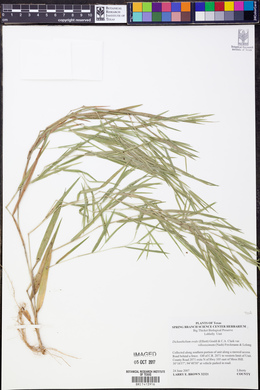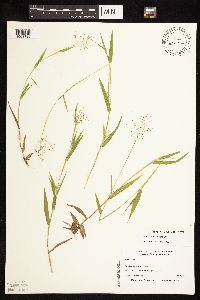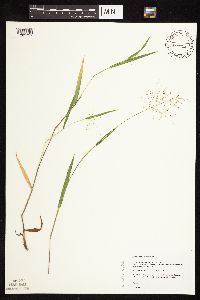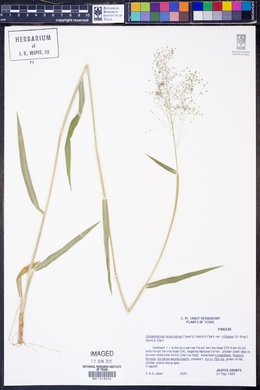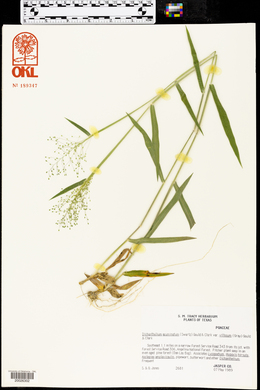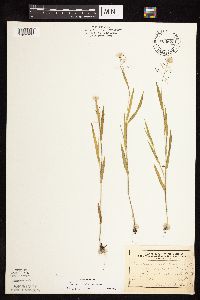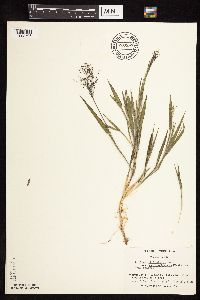Dichanthelium ovale subsp. villosissimum
|
|
|
|
Family: Poaceae
Egg-Leaf Witch Grass
[Dichanthelium acuminatum var. villosum (A. Gray) Gould & C.A. Clark] |
Basal blades 3-7 cm, evenly long pilose. Culms more than 1 mm thick, stiff, often decumbent or prostrate in the fall; internodes with soft, spreading or retrorse, papillose-based hairs, hairs longer than 4 mm. Cauline sheaths with soft, spreading or retrorse hairs, hairs longer than 4 mm, papillose-based; ligules 2-5 mm; blades 6-10 mm wide, both surfaces densely pilose, hairs longer than 4 mm, margins short-ciliate basally, scabridulous and faintly whitish elsewhere. Spikelets 2.1-2.5 mm, usually ellipsoid, with dense, spreading, papillose-based hairs. Lower glumes 1/3-1/2 as long as the spikelets, usually acute. 2n = 18. Dichanthelium ovale subsp. villosissimum grows in dry, sandy, open pine and oak woodlands. It and subsp. pseudopubescens are the most common and widespread subspecies throughout the eastern United States. The range of subsp. villosissimum extends to Mexico, Honduras, Guatemala, and Nicaragua. It grades into the less pubescent subsp. pseudopubescens, and occasional specimens with smaller spikelets approach D. acuminatum subsp. acuminatum, which is usually densely grayish, velvety-pubescent. Perennial herb, tufted 15 cm - 0.6 m tall Inflorescence: a terminal, branched arrangement of spikelets (panicle). Primary panicles atop the culms, 3 - 10 cm long, almost as wide when fully open. Secondary panicles (when present) atop the branches. Fruit: a caryopsis, indehiscent, enclosed within the persistent lemma and palea. Culm: stiff, mostly spreading or ascending, 15 cm - 0.6 m long, over 1 mm thick, round in cross-section, hollow, with spreading or down-pointing hairs that are bumpy-based and longer than 4 mm long. Nodes sparsely to densely bearded. Fall phase with decumbent culms, forming dense clusters of branches that have upright, slightly reduced leaf blades and highly reduced secondary panicles. Spikelets: 2 - 2.5 mm long, ellipsoid with a blunt to nearly pointed apex, with spreading and dense, bumpy-based hairs. Basal leaves: in a rosette. Blades 3 - 7 cm long, lance-shaped, distinct from the stem blades, softly hairy with long hairs, often marginally fringed with hairs. Stem leaves: four to seven, alternate, two-ranked. Sheaths shorter than internodes, with spreading or down-pointing hairs that are bumpy-based and longer than 4 mm long. Ligules 2 - 5 mm long, composed of hairs. Blades relatively firm, spreading or ascending, distinctly longer and narrower than basal leaves, 4 - 10 cm long, 6 - 10 mm wide, lance-shaped with a rounded or slightly narrowed base, parallel-veined, densely soft-hairy (hairs over 4 mm long), marginally whitish and minutely rough, fringed with short hairs basally. Glumes:: Lower glumes one-third to one-half as long as spikelets, triangular with a pointed apex, veined (not strongly). Upper glumes a bit shorter than lower lemmas and upper florets when mature, veined (not strongly). Lemmas:: Lower lemmas similar to upper glumes. Upper lemmas longitudinally lined, shiny, with rolled-up margins above. Paleas:: Lower paleas shorter than lower lemmas, thin. Upper paleas longitudinally lined. Florets:: Lower florets sterile. Upper florets bisexual, stalkless, 1.5 - 2.5 mm long, a bit less than half as wide as long, ellipsoid with a nearly pointed apex, plump. Anthers three. Stigmas red. Similar species: No information at this time. Flowering: late May to late June Habitat and ecology: Found in the sandy fields and woods in the eastern sector of the Chicago Region. In the western sector it can be found in dry prairies. Occurence in the Chicago region: native Etymology: Dichanthelium comes from the Greek words di, meaning twice, and anth, meaning flowering, referring to plants that may have two flowering periods. Ovale means oval. Villosissimum means "very long-hairy." Author: The Morton Arboretum From Flora of Indiana (1940) by Charles C. Deam Local probably throughout the lake area. It is found in open places in dry, sandy or gravelly soil, usually on black and white oak ridges and in the dunes. ...... Treated as a distinct species, D. villosissimum, by J. Thomas (2015) and seems to have a broader distribution than described by Deam (1940). Nonetheless, it is limited to counties north of the Central Till Plain. Indiana Coefficient of Conservatism: C = 6 Wetland Indicator Status: FACU
|
















